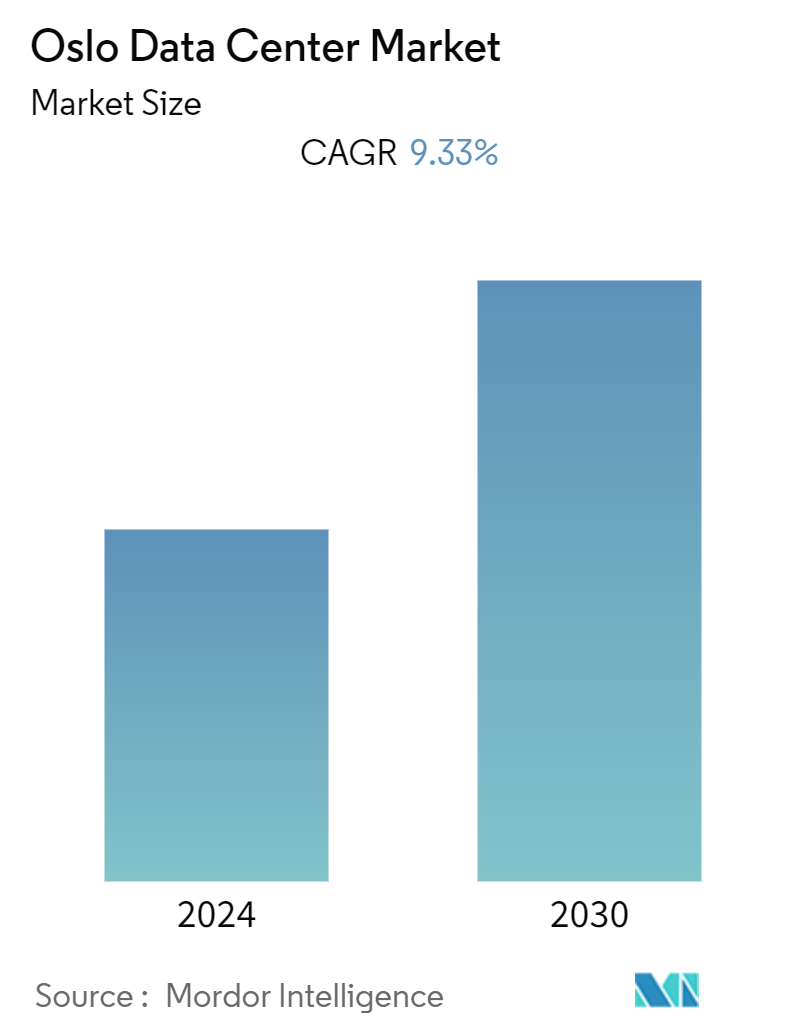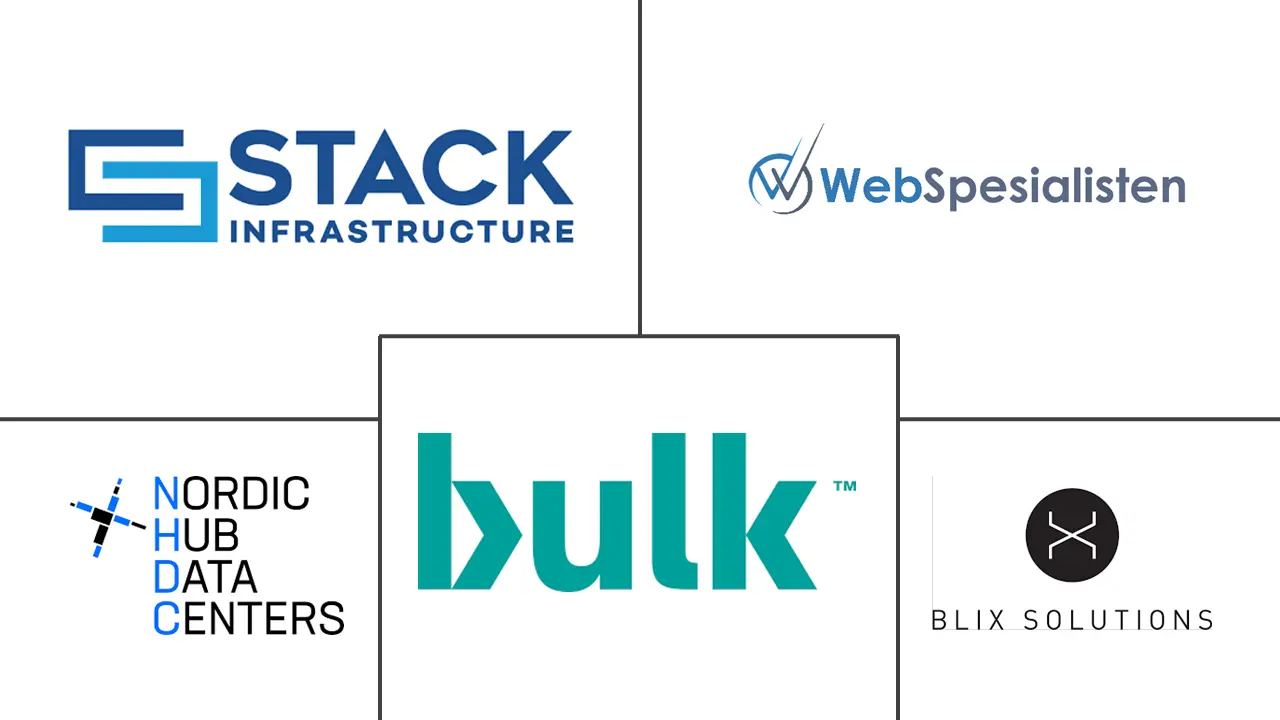| Study Period | 2018 - 2030 |
| Base Year For Estimation | 2023 |
| Forecast Data Period | 2024 - 2030 |
| Historical Data Period | 2018 - 2022 |
| CAGR | 9.33 % |
| Market Concentration | Medium |
Major Players*Disclaimer: Major Players sorted in no particular order |
Oslo Data Center Market Analysis
The Oslo Data Center Market is expected to register a CAGR of 9.33% during the forecast period.
The main drivers anticipated to drive market expansion are the increasing demand for energy-efficient data centers, considerable investment by colocation and managed service providers, and expanding hyperscale data center buildings. Additionally, the development of big data, cloud computing, and the Internet of Things (IoT) has made it possible for businesses to invest in new data centers to preserve business continuity.
- Additionally, industrial development is expected to prosper due to the rising need for security, operational efficiency, improved mobility, and bandwidth. Software-based data centers boost industry growth by providing a higher level of automation.
- The Norwegian government has been actively promoting the establishment of data centers in Oslo, citing its cool climate and use of renewable energy as advantages for such facilities. The government released its data center strategy, "Powered by Nature," which aims to make Norway a leading location for data centers powered by renewable energy. The government is also encouraging data centers and other large electricity users to explore offering their waste heat to district heating schemes to improve energy efficiency. In addition, the government supports establishing data centers in Oslo through initiatives such as tax incentives and direct investment.
- Going green is no longer simply an industrial goal but is being aggressively pursued to attain the goal of negative carbon footprints. Businesses and data center service providers are investigating energy efficiency, water usage, and waste output. Organizations like Microsoft aim to make their DC operations run entirely on renewable energy. Companies in the data center technology industry are also experimenting with Tesla Megapacks for large-scale energy storage. This will aid in increasing the use of solar energy in large data centers. Businesses' climate action framework will undergo a dramatic paradigm shift in 2022.
- More than any other application, artificial intelligence (AI) with machine learning (ML) requires the construction of a whole new data center architecture. AI and machine learning (ML) may require three times the power density of typical data processing, necessitating a data center architecture revolution. To sustain the higher output, specialized cooling systems are also required. Because of the intensive nature of AI and ML computations, there may be a large dispersion of computational, memory, and storage resources among multiple processors in a computing cluster.
- Furthermore, development centers have conducted extensive research on energy efficiency in data centers, focusing on optimal service quality, effective resource utilization, and cost-cutting operations. They want to reduce brown energy use by providing a load-balancing system that maximizes available green energy. Load balancing is a renewable energy-based technology implemented in various data centers. A workload and energy management plan was implemented to reduce network operational and energy expenses. Combined cooling, heating, and power (CCHP) systems can significantly reduce carbon emissions and air pollution while enhancing resource efficiency.
Oslo Data Center Industry Segmentation
A data center is a physical room, building, or facility that holds IT infrastructure used to construct, run, and provide applications and services, as well as store and manage the data connected with them.
The Oslo data center market is segmented by DC size (small, medium, large, massive, mega), by tier type (tier 1 and 2, Tier 3, Tier 4), by absorption (utilized, colocation type (retail, wholescale, hyperscale), end-user (cloud & IT, telecom, media & entertainment, government, BFSI, manufacturing, e-commerce), and non-utilized).
The market sizes and forecasts are provided in terms of volume (MW) for all the above segments.
| Small |
| Medium |
| Large |
| Massive |
| Mega |
| Tier 1 & 2 |
| Tier 3 |
| Tier 4 |
| Utilized | Colocation Type | Retail | |
| Wholesale | |||
| Hyperscale | |||
| End-User | Cloud & IT | ||
| Telecom | |||
| Media & Entertainment | |||
| Government | |||
| BFSI | |||
| Manufacturing | |||
| E-Commerce | |||
| Other End-User | |||
| Non-Utilized | |||
Oslo Data Center Market Size Summary
The Oslo data center market is poised for significant growth, driven by the increasing demand for energy-efficient solutions and substantial investments from colocation and managed service providers. The expansion of hyperscale data centers, coupled with advancements in big data, cloud computing, and the Internet of Things, has encouraged businesses to invest in new facilities to ensure business continuity. The Norwegian government's proactive stance, promoting data centers in Oslo through initiatives like "Powered by Nature," leverages the region's cool climate and renewable energy sources. This strategy aims to position Norway as a leader in sustainable data center operations, supported by tax incentives and direct investments to enhance energy efficiency and reduce carbon footprints.
The market is further bolstered by the rising need for security, operational efficiency, and improved mobility, with software-based data centers offering higher automation levels. The demand for Tier III facilities is growing, providing robust uptime and features akin to Tier IV infrastructures, catering to larger enterprises and fast-growing businesses. The BFSI sector's digital transformation, driven by the adoption of mobile banking and digital payment methods, is a significant contributor to market expansion. Companies are increasingly adopting data center as a service (DCaaS) models to balance the power and control of on-premises solutions with the flexibility and cost-effectiveness of the cloud. This trend, alongside strategic partnerships and expansions by key players, underscores the Oslo data center market's dynamic and evolving landscape.
Oslo Data Center Market Size - Table of Contents
1. MARKET SEGMENTATION
-
1.1 DC Size
- 1.1.1 Small
- 1.1.2 Medium
- 1.1.3 Large
- 1.1.4 Massive
- 1.1.5 Mega
-
1.2 Tier Type
- 1.2.1 Tier 1 & 2
- 1.2.2 Tier 3
- 1.2.3 Tier 4
-
1.3 Absorption
- 1.3.1 Utilized
- 1.3.1.1 Colocation Type
- 1.3.1.1.1 Retail
- 1.3.1.1.2 Wholesale
- 1.3.1.1.3 Hyperscale
- 1.3.1.2 End-User
- 1.3.1.2.1 Cloud & IT
- 1.3.1.2.2 Telecom
- 1.3.1.2.3 Media & Entertainment
- 1.3.1.2.4 Government
- 1.3.1.2.5 BFSI
- 1.3.1.2.6 Manufacturing
- 1.3.1.2.7 E-Commerce
- 1.3.1.2.8 Other End-User
- 1.3.2 Non-Utilized
Oslo Data Center Market Research Faqs
What is the current Oslo Data Center Market size?
The Oslo Data Center Market is projected to register a CAGR of 9.33% during the forecast period (2025-2031)
Who are the key players in Oslo Data Center Market?
Stack Infrastructure, Inc., Bulk Infrastructure Group AS, Blix Solutions AS, Nordic Hub Data Centers AS, Webspesialisten AS, Green Mountain AS and Orange Business Service are the major companies operating in the Oslo Data Center Market.




